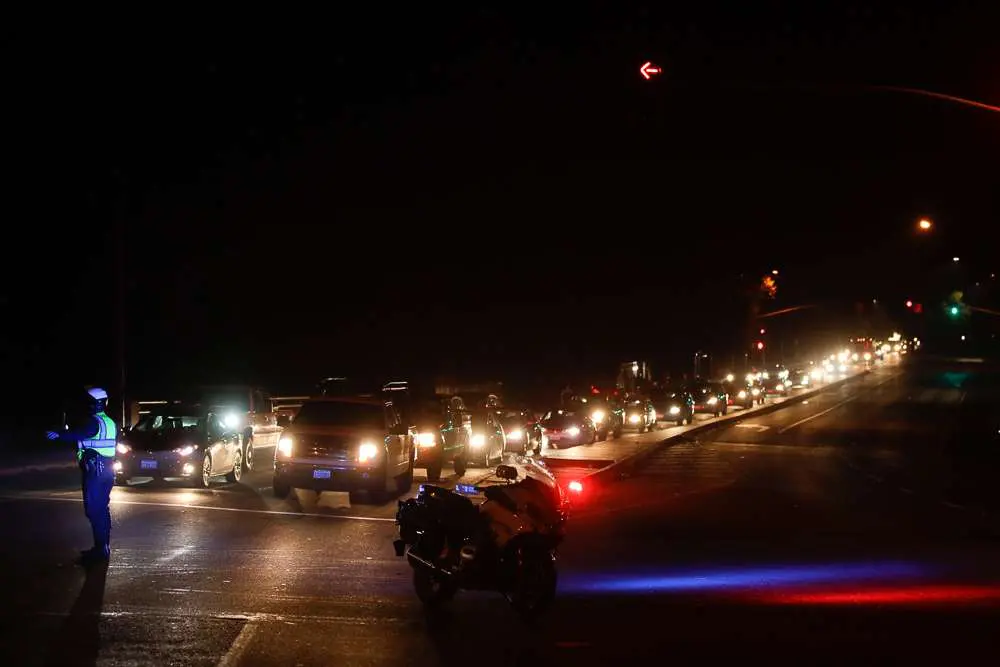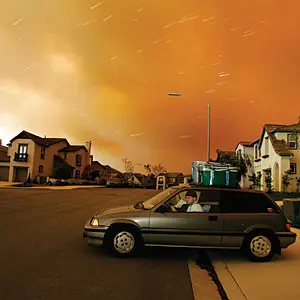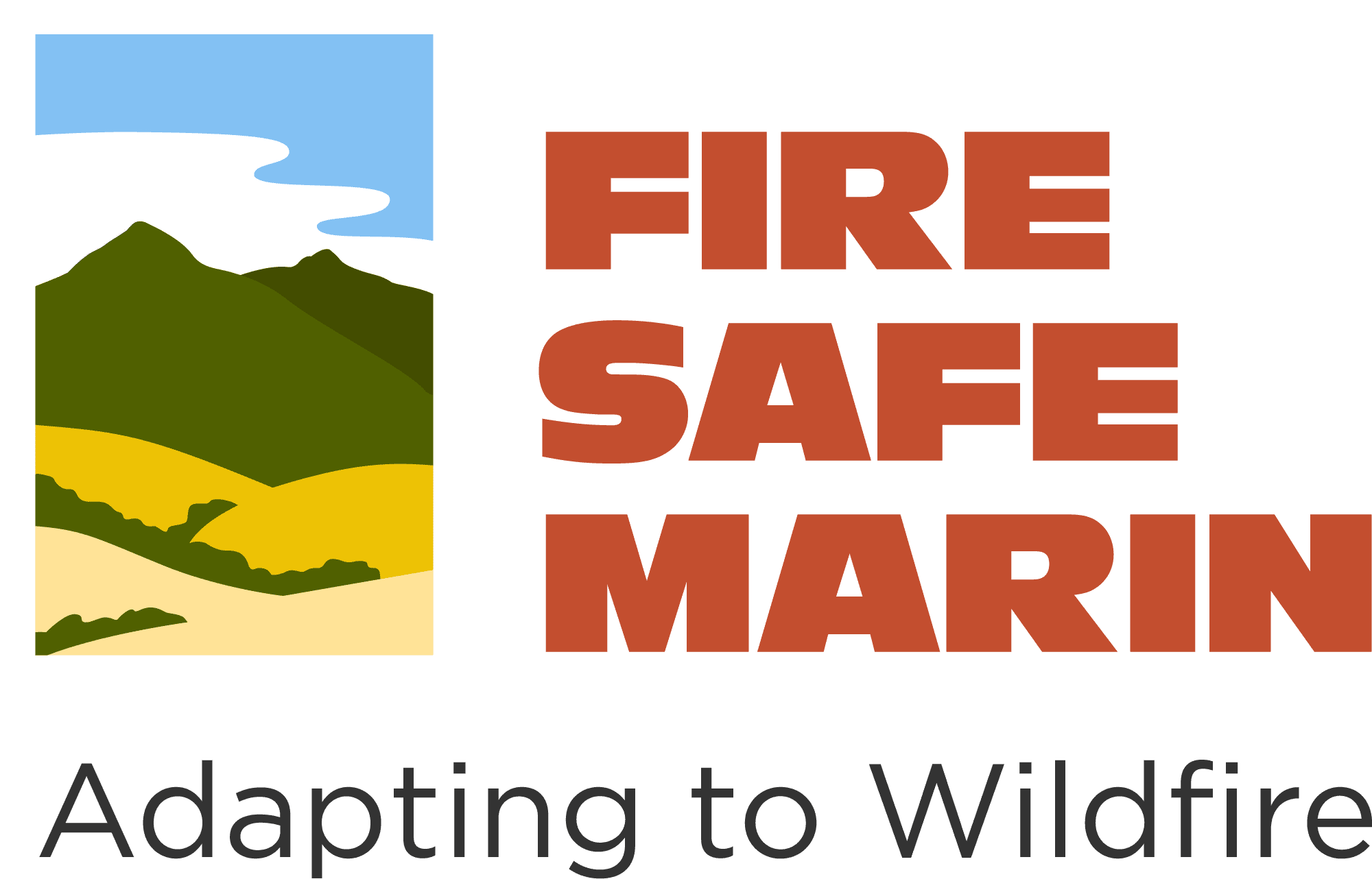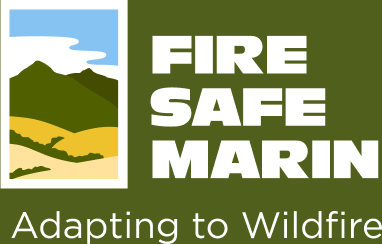
IMPORTANT! TO RECEIVE EVACUATION NOTICES IN MARIN, YOU MUST REGISTER FOR ALERT MARIN! WWW.ALERTMARIN.ORG
If you live in Marin, you must be prepared to evacuate from wildfire. Although Marin’s hillside neighborhoods and “Wildland Urban Interface” (WUI) areas are most at risk, the recent fires in Santa Rosa, Sonoma, and Napa show what we’ve always understood – under extreme conditions and winds, all communities are potentially at risk. Evacuation planning and disaster preparedness are vital to your family’s safety – during large scale and fast moving disasters, you can’t count on first-responders arriving to help you in 5 minutes or less like you can on a normal day.
While Marin fire and law enforcement agencies have developed detailed plans and protocols to respond to large wildfires and evacuate residents under variable conditions, it is imperative that residents understand the risk and prepare in advance to evacuate. The Marin County Fire Chiefs Association and Fire Safe Marin adopted the Ready-Set-Go wildfire preparedness concept years ago to help educated citizens on their responsibilities and options before, during, and after a wildfire.
Please read our Evacuation Preparedness materials and familiarize yourself with evacuation procedures TODAY. Your life may depend on it TONIGHT.
- Register for Alert Marin
- Wildfire Evacuation Guide
- Evacuation Checklist
- Evacuating Pets
- Evacuating Large Animals
Evacuation Guidelines For Marin Residents
Evacuations save lives and allow responding personnel to focus on the emergency at hand. Please evacuate promptly when requested! Your life is at stake!
ALERT MARIN
If a wildfire requires evacuation in Marin and time allows, emergency managers will use the “Alert Marin” system to send out notifications by telephone, cellular, VOIP, and text message. If you live, work or go to school in Marin County, you may register your cell phone or VOIP (voice over internet protocol) phone to receive emergency alerts sent by call, text, email, or smartphone application from the County of Marin.
REGISTER YOUR CELL PHONE OR VOIP FOR ALERT MARIN TODAY!
It is important to know that Alert Marin is NOT NIXLE! Some Marin law enforcement agencies use the Nixle opt-in service to annnounce local activity, and they may rebroadcast evacuation alerts, but Alert Marin is a separate and distinct system. You MUST register to receive Alert Marin evacuation messages by cell phone or VOIP (Comcast, DSL, or satellite home phones, for example). Register every phone number and device in your household. Don’t delay.
Be sure to verify that Wireless Emergency Alerts (Amber alerts and Emergency Alerts) are turned on in your cell-phone’s settings. Fore example, on an iPhone, under settings/notifications, scroll to the bottom of the page and ensure all alerts are turned ON. Contact you carrier or phone manufacturer for instructions.
EVACUATION ORDERS
The terms Voluntary and Mandatory are often used to describe evacuation orders. In Marin, fire agencies and law enforcement will use the terms Evacuation Order, Evacuation Warning, and Shelter In Place. These terms are used to alert you to the significance of the danger and provide basic instructions. All evacuation instructions provided by officials should be followed immediately for your safety.
Evacuation Order
- Fire expected to arrive in less than 1 hour, with threat to civilian life. Evacuate immediately, do not delay to gather belongings or prepare your home.
Evacuation Warning
- Fire expected to arrive in 2 hours or more, with threat to civilian life. Evacuate as soon as possible. A short delay to gather your evacuation kit and prepare your home (see Evacuation Checklist) may be ok.
Shelter in place
- Community members should stay secured in current location. Sheltering in place may be used when evacuation would cause greater threat to life.
BEFORE A FIRE THREATENS
At all times during fire season, prepare an Evacuation Kit. Keep the evacuation kit in your vehicle or near an exit. Your kit should include:
- Critical medications
- Important personal papers, photos.
- Essential valuables.
- Pet and livestock transport, limited amount of pet food.
- Change of clothing, toiletries.
- Cell phone.
- Spare batteries and chargers.
- Critical papers and effects in a fire-proof safe.
- AM/FM radio.
- An Evacuation Route Map with at least two routes (if possible).*
- Drive your planned route of escape before an actual emergency.*
*During an evacuation, law enforcement or emergency personnel may direct you to an alternate route. Always follow their directions.
WHEN EVACUATION IS A POSSIBILITY
 Complete our Evacuation Checklist if time allows.
Complete our Evacuation Checklist if time allows.- Locate your Evacuation Kit and place the items in your vehicle.
- Park your vehicle facing outward and carry your car keys with you.
- Place your pets in crates or carriers BEFORE evacuation is ordered and keep them nearby.
- Prepare large animals for transport.
- Place connected garden hoses and buckets full of water around the house. Attach “grip” type nozzles to hoses if you have them. You should have multiple garden hoses long enough to reach all corners of your home. Firefighters will use them.
- Move propane BBQ appliances away from structures and close valves.
- Cover-up. Wear long pants, long sleeve shirt, heavy shoes/boots, cap, use a dry-bandana for face cover, wear goggles or glasses. 100% cotton or wool is preferable to synthetic fabrics.
- Leave all lights on in and around the house and unlock all doors.
- Close all windows and turn air conditioning and fans off.
- Check on neighbors and make sure they are preparing to leave.
- Patrol your property and monitor the fire situation.
- Evacuate immediately if you feel threatened. Do not wait for an evacuation order.
THE EVACUATION PROCESS
Fire officials will determine the areas to be evacuated and the routes to use depending upon the fire’s location, behavior, winds, terrain, etc. Law enforcement agencies are responsible for enforcing an evacuation order. Follow their directions or the directions of firefighters promptly.
When time allows, emergency managers will attempt to advise you of potential evacuations as early as possible. You must take the initiative to stay informed and aware. There is no guarntee that you will receive notification of an evacuation order (for example, if the fire spreads too rapidly to allow for notofication, if a power failure or the fire itself disables communication infrastructure, if your phone battery is dead or if you failed to “opt-in” to emergency alerts). Listen to your radio or TV for announcements from law enforcement and emergency personnel.
Be sure to have signed up for the Alert Marin system BEFORE a fire threatens you.
You may be directed to temporary assembly areas to await transfer to a safe location. Evacuate to the nearest major community AWAY from the fire.
WHEN TO EVACUATE
Leave immediately if you receive a notification or alert to avoid being caught in fire, smoke or road congestion. Don’t wait to be ordered by authorities to leave if you are unsure, feel threatened, or lose power or communications. Law enforcement will direct the evacuation, and they will keep intersections open and moving, but their resources may be limited. Evacuating early (before evacuation is ordered) helps keep roads clear of congestion, and lets fire apparatus move more freely to do their job. If you are advised to leave, don’t hesitate!
- The fire Incident Commander will issue the evacuation order through thte Sheriff’s Office, and will determine the areas to be evacuated and escape routes to use (if there are options) depending upon the fire’s location, behavior, winds, terrain, etc.
- Law enforcement agencies are responsible for enforcing an evacuation order. Follow their directions promptly.
- You will be advised of potential evacuations as early as possible by Alert Marin. YOU MUST REGISTER TO RECEIVE ALERTS.
- You must take the initiative to stay informed and aware. Listen to your radio (AM 1610, AM 840, and others) and TV for announcements from law enforcement and emergency personnel.
- You may be directed to temporary assembly areas to await transfer to a safe location.
- All evacuation instructions provided by officials should be followed immediately for your safety.
Law enforcement can move a large number of vehicles through intersections. Don’t panic! Don’t avoid evacuating out of fear that your road will be blocked or congested. Drive clamly and safely. Turn your lights on.
WHAT IF MY ROAD IS BLOCKED?
- If an alternate route is available, take it.
- If the road is blocked, try to clear the obstruction.
- Do not leave your vehicle if fire is burning on the roadsides unless there is no other option or your car is on fire. Leaving your car is a last resort and may prove deadly. You are almost always safer in your car or a building.
- Do not abandon your car in the roadway. Park it off the road if there is no other option.
- Take shelter in a building if no quick escape route is available. Close doors and windows, stay low (lay on the floor, crawl to move if there is smoke or heat in the building, and stay near a door. Stay inside until the fire passes or conditions become untenable.
MY NEIGHBORHOOD IS ONE WAY IN, ONE WAY OUT!
If you live in a “one way in, one way out” neighborhood, as is common in Marin, your escape route is predetermined.
- Use the one-way-out direction and leave! Drive towards your neighborhoods exit, and to the nearest town away from the fire.
- Carpooling saves more than gas. If your neighbors (especially the elderly or disbled) can fit in your car, take them. Fewer cars on the road are better.
- Follow instructions in the alert messages if they provide evacuation shelter or escape route information.
- Do not flee to fire roads or vegetated open spaces. Fire roads are more dangerous than being in your car on the pavement, even with fire burning around you.
- But fire engines will block my escape!
- WRONG! During an evacuation, the fire’s Incident Commander will instruct fire engines not to enter areas where evacuation is occurring and two-way passage is not possible. Evacuation is the number one priority for firefighters.
IF YOU ARE UNABLE TO EVACUATE ON YOUR OWN
- Ask a neighbor to assist you or give you a ride.
- Call 911 if you are disabled or need assistance to evacuate.
- If first responders are in your neighborhood, notify them that you require assistance.
FIRE ROADS
Fire roads (or other unpaved or locked roads leading to open spaces) are not safe or viable evacuation routes during wildfires! Stay on pavement and evacuate towards major roads and away from the fire, unless instructed otherwise by emergency personnel. If you’ve been told by a friend or neighbor to evacuate to a fire road or vegetated open space area, you’ve been dangerously misinformed! If your evacuation route is blocked, you’re almost always better off remaining in your car or taking shelter in a house until the fire passes.
During wildfires, always follow the instructions of law enforcement officers or firefighters.
Unless instructed otherwise, you should ALWAYS plan to evacuate downhill towards major roads and away from the fire.
IF YOU BECOME TRAPPED
INSIDE THE HOME
- Keep all family members together.
- Stay inside the house until the fire front passes.
- Plan for the loss of power and have water stored by filling the sinks and tubs along with buckets inside your house to put out burning embers or small fires.
- Have ygarden hoses and fire extinguishers out and in convenient locations.
- Shelter near a n exit door on the opposite end of your home from where the fire is approaching; making sure you have two possible exit routes.
- Always stay near an exit door, low to the floor. Crawl to move if there is smoke or heat in the house. Exit if it becomes difficult to breathe or too hot to stay.
- Close all windows and doors.
- If you havean automatic garage door opener, disconnect the unit and operate the door manually. Close the garage door after exiting (you may not be able to reopen if the manual latch has been operted. Become familiar with manual door operation BEFORE a fire strikes!).
- Close metal Venetian blinds.
- Remove light curtains and other easily combustible materials from windows or draw them well past the perimeter of the window. This will prevent radiant heat from catching the window coverings on fire.
- Move furniture away from windows and sliding glass doors to prevent radiant heat from catching the furniture on fire.
- Shut off all attic fans, whole house fans, swamp coolers and interior fans to keep smoke and ash from being drawn into house.
- Bring pets inside and place in pet carriers to control their movement in the house as the roar of the fire comes.
- Put livestock and horses in an area where fuels have been removed or in an irrigated pasture.
- Leave exterior and interior lights on for as long as you have power. This helps firefighters to find your house in the dense smoke during a fire.
- Move wheeled vehicles or equipment away from structures.
- Shut off natural gas and propane unless needed for running a generator.
- Connect water hoses and lay them out for best use where they will not get burned during the fire front passing.
- If you have a wooden fence that connects to the exterior of your home, open the gate to prevent flames from spreading from the fence to your house.
- Move anything that can easily ignite at least 30 feet away from the exterior of your home, including patio furniture and cushions, cloth awnings, barbecues, portable propane tanks, trash cans without lids, and firewood.
OUTSIDE THE HOME OR ON FOOT
- Find an area clear of vegetation, fand far from dry grass, brush, or trees. Look for a ditch, depression, or body of water such as a pool or lake, if possible.
- Lie face down, cover up your body. Protect your airway, by breatheing close to the ground, through a dry towel or cloth.
- Use your cell phone to call 911. Advise officials that you are trapped and provide your location (an address or intersection is best).
IN YOUR VEHICLE
- A structure offers more protection than a car so if you are trapped in your car and there is a building nearby get inside it.
- If there is no building, park and stay in your car, where it is safer than being out in the open where you could be directly exposure to flames and radiant heat.
- Do not abandon your car in the roadway.
- Find a safe place to park that has little or no vegetation.
- Turn on headlights and emergency flashers to make your car more visible during heavy smoke.
- Close all windows and doors, shut off all air vents, and turn off the air conditioner.
- Get below the windows under blankets, preferably wool, and lie on the floor to shelter yourself from the intense radiant heat.
- Stay in the vehicle, as it will provide you with protection from the heat and smoke.
- Wait until the fire front passes and temperature has dropped outside then get out and into a safe area that has already burned.
RETURNING HOME
Fire officials will determine when it is safe for you to return to your home. This will be done as soon as possible considering safety and accessibility.
When you return home:
- Be alert for downed power lines and other hazards
- Check propane tanks, regulators, and lines before turning gas on
- Check your residence carefully for hidden embers or smoldering fires







